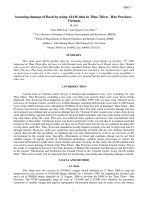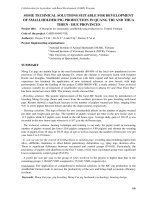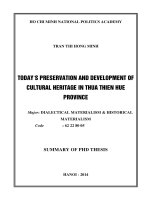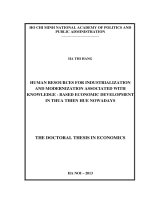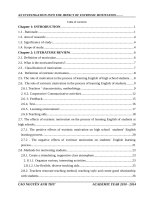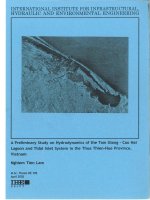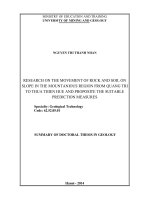Positive oral feedback in EFL classrooms: EFL teachers’ perceptions and practice at some upper-secondary schools in Thua Thien Hue
Bạn đang xem bản rút gọn của tài liệu. Xem và tải ngay bản đầy đủ của tài liệu tại đây (544.35 KB, 10 trang )
POSITIVE ORAL FEEDBACK IN EFL CLASSROOMS:
EFL TEACHERS’ PERCEPTIONS AND PRACTICE
AT SOME UPPER-SECONDARY SCHOOLS IN THUA THIEN HUE
PHAN THI THU HIEU, TRUONG VIEN
University of Foreign Languages, Hue University
Abstract: In EFL classrooms, teachers tend to adopt a variety of techniques
to enhance students’ motivation and hence their achievement. One of them is
positive oral feedback. The aim of this paper is to examine the use of
positive oral feedback in EFL classrooms by English teachers at some upper
secondary schools in Thua Thien Hue Province. The instruments used for
collecting the data include the questionnaire, interviews and class
observations, and there were fifty EFL upper secondary school teachers who
participated in the research. The findings showed that high school English
teachers had positive perceptions towards positive oral feedback. However,
there was a slight difference between perceptions and practice of giving
positive oral feedback.
Keywords: Positive oral feedback, English teachers, perceptions, practice,
high schools, students’ motivation.
1. INTRODUCTION
Teachers’ feedback plays a crucial role in students’ progress, since it is used to boost
their engagement in classroom. Obviously, there is a variety of feedback types that
teachers can apply in language classroom so as to encourage students’ involvement and
language performance and improvement. Positive oral feedback is one of many
communication techniques that can be employed by language teachers who either
correct learners’ performance implicitly or explicitly or ask them to clarify what they
say in different contexts of language practice.
In EFL environments like Vietnam, it is interesting to see how oral feedback, especially
positive oral feedback, works in different learning contexts and through various
classroom purposes so that the tool can be used in a more effective way by both
language teachers and learners.
2. LITERATURE REVIEW
2.1. Feedback in EFL classrooms
In education, feedback is one aspect that is quite important to increase the students’
motivation (DeNisi & Kluger, 2000). Specifically, feedback, in education, in a teacherstudent learning environment can be defined as “information given to learners which
they can use to revise their inter-language” (Ellis, 1999:702). This is somehow related
Journal of Science, Hue University of Education
ISSN 1859-1612, No. 02(50)/2019: pp. 5-14
Received: 01/10/2018; Revised: 18/10/2018; Accepted: 19/10/2018
6
PHAN THI THU HIEU, TRUONG VIEN
to the definition of feedback in general, in which they are both beneficial to the
receivers/learners in terms of revision for the next time.
When focusing on oral feedback especially, a division can be made on the basis of a
task type or activity. Oral feedback as a topic strongly relates to the area of feedback
and the role of the teacher in the classroom. According to various researchers, oral
feedback has proven to be an effective tool in SLA classrooms (Lyster el al., 2013).
Oral feedback has been studied according to the situation it is used in (Harmer, 2001).
There are some types of teachers’ oral feedback. They are evaluative feedback,
corrective feedback, descriptive feedback, interactional feedback, and motivational
feedback. Evaluative feedback regards the form of judgment on students’ performance
or work (Tunstall & Gipps, 1996). Tunstall & Gipps (1996) classified ways of
evaluative feedback into rewarding, punishing, approving, and disapproving. Corrective
feedback is a response given to a learner’s error (Ellis, 2006). Lyster and Ranta (1997)
classified corrective feedback into recast, explicit correction, elicitation, metalinguistic
feedback, and repetition.
2.2. Positive oral feedback
Positive feedback is given by teachers to students to provide reinforcement in terms of
learning. For example, when students do respond, the teachers give positive oral
feedback to students as “good job, needs to be improved this part” or “excellent”,
“good”, etc. (Ellis, 2009). She also stated that a good reinforcement for students is
positive feedback, because then students can be motivated to learn more (DeNisi and
Kluger, 2000). Furthermore, it provides reinforcement in terms of learning. In the same
manner, offering praise or positive oral feedback can increase learners’ satisfaction and
lift their learning spirit. Brown (1994, p.58), for example, recommends that teachers use
immediate verbal praise as a form of short-term reward to keep students confident in
their ability. In conclusion, the technique of giving oral feedback proves its benefits in
language classrooms, and is grounded on sound assumptions of ELT methodology by
established authors in the field, and the practice of this technique has so far been studied
in language classrooms in the world.
2.3. Related studies on the use of oral feedback in EFL classrooms
Marko (2007) conducted a study on the effectiveness of teacher oral feedback in an
ESL/EFL classroom at the University of Oregon’s American English Institute. In order
to collect the data, three types of instruments were used: student and instructor
questionnaires, observation instruments, pre and post-observation interview forms.
There were 8 instructors and one level 5 reading/ writing/ grammar class of 15 students
at American English Institute. Six of the instructors and 13 of the students returned
completed questionnaires and became final participants of the study. Data collected
from teachers about teacher oral feedback show that there is consistently a reasonable
amount of positive feedback for every teacher who filled in the questionnaire. The
finding showed that teachers’ verbal feedback and praise had a significant positive
POSITIVE ORAL FEEDBACK IN EFL CLASSROOMS: EFL TEACHERS’ PERCEPTIONS...
7
impact on the learners’ motivation in learning and participation and hence their
achievements.
Farah (2015) conducted a case study of students at one of junior high schools in
Bandung, Indonesia: “Teachers’ praises and students’ engagement in EFL classrooms”.
The study analyzed the use of praise and its influence toward students’ engagement. The
population of this research included an English teacher of EFL classroom and 260
students of seventh grade in one public Junior High School in Bandung. Qualitative
approach was employed in this study. The data of this study were obtained from
classroom observation through video-recording. The result of this study showed that the
way teacher gives praise to the students is in line with the theory of effective praise. The
observed teacher in this study gave praise to the students in four steps: description of
appropriate behavior rationale, request acknowledgment, and positive consequence. In
addition, the result of the study also showed students’ positive engagement after being
praised by the teacher. There were five characteristics of students’ engagement that
appeared during classroom observation: positive body language, consistent focus, verbal
participation, students’ confidence, and fun and excitement. In conclusion, the use of
praise would influence students’ positive engagement if it was given properly.
Abbasi et al (2015) emphasized the importance of positive oral feedback by conducting
a study aiming at exploring the effects of teachers’ verbal feedback and praise on
students’ achievements. The participants of the study were all EFL leaners of Navid
English institute in Jahrom. A pre/post test was used as the research tool and two groups
of female students participated in this study (N=30) under two conditions: no feedback,
feedback and praise provided by the instructor. The findings showed that teachers’
verbal feedback and praise had a significant positive impact on the learners’ motivation
and hence their achievements. As a result of giving feedback and praise to the students
and their effects on motivation and achievements, it can be argued that the more
motivated students are, the more and the better they will learn.
Ramon (2016) conducted a study at a university in Chile, which presents an analysis of
the insights of 28 EFL teachers and their stated perceptions about oral corrective
feedback. It appeared that most of the teachers were not fully aware of the frequency
and the amount of feedback they tended to provide and when to do it, nor of the
different types of correction they used. Even though all the teachers acknowledged the
importance of feedback, they expressed concerns about interrupting students and
provoking negative affective responses. Informing teachers of the results of corrective
feedback research can encourage them to use a wider variety of techniques and possibly
make their teaching more effective and at the same time improve students’ oral
proficiency. The findings of this study contributed to the comprehension of teachers’
perceptions on students’ feelings and attitudes in learning their foreign languages.
However, there has still little research into using positive oral feedback in upper
secondary schools and such aspects as reality of implementing positive oral feedback
have not been focused on for the benefit of EFL better teaching and learning. This
8
PHAN THI THU HIEU, TRUONG VIEN
research is hoped to bridge this gap of research by means of exploring EFL teachers’
perceptions and actual practice of the technique.
3. THE STUDY
3.1. Purposes
The research aims at answering the following research questions:
1. What are the teachers’ perceptions towards giving positive oral feedback in EFL classrooms?
2. What is the current practice of giving positive oral feedback in EFL classrooms by
the teachers?
3.2. Participants and research site
Fifty English teachers at five different high schools in Thua Thien Hue participated in
this study, who were between the ages of 24-58. There were 3 male teachers and 47
female ones. Their teaching experiences ranged from 2 to more than 20 years.
3.3. Research methods
Firstly, a survey questionnaire translated into Vietnamese was conducted. It consisted of
two clusters with 35 items and it was rated to a five-point Likert scale (1: strongly
disagree, 2: disagree, 3: neutral, 4; agree, 5: strongly agree). Then interviews were
carried out with 8 English teachers, which consisted of eight open-ended questions in
order to cross check the teachers’ responses in the questionnaires and gain more
information about teachers’ perceptions and practice of giving positive oral feedback in
EFL classrooms. Finally, class observations were conducted with eight different classes.
There were four lessons in total to be observed, in which each skill was observed with
two different teachers to gain an insight into the real practice of teachers in giving
positive oral feedback.
4. RESULTS
4.1. Teachers’ perceptions towards the use of positive oral feedback in EFL
classrooms
4.1.1. Findings from questionnaire data
Table 1. Descriptive statistics of perceptions of high school English language teachers
towards the use of positive oral feedback in EFL classrooms
Descriptive Statistics
N
Perceptions of high school EFL teachers towards
positive oral feedback in EFL classrooms.
1. The importance of positive oral feedback in EFL
classrooms
2. Areas for positive oral feedback
3. When positive oral feedback can be given
Min
Max Mean
SD
50
3.89
4.79
4.39
.21771
50
3.88
5.00
4.44
.27798
50
50
3.43
3.50
4.71
5.00
4.28
4.49
.30611
.34241
POSITIVE ORAL FEEDBACK IN EFL CLASSROOMS: EFL TEACHERS’ PERCEPTIONS...
9
The perceptions of EFL teachers towards positive oral feedback are presented and
analyzed in Table 1.
Firstly, as can be drawn from the data collected in Table 1, positive oral feedback was
supported highly by the teachers (M= 4.39 for the whole cluster, and M=4.44 for the
importance of positive oral feedback). According to the majority of teachers, the
classroom environment depends chiefly on students’ attitude towards learning and
positive oral feedback and praise play a crucial role in teaching and motivating students
in learning. Besides, it is found out that students are also interested in being praised and
positively commented, which help them make progress if they know their strength or
weaknesses that need to be corrected by their teachers. Furthermore, the majority of the
participants also agree that learning a language requires a lot of self-confidence and it is
teachers’ encouragements that make them more confident.
Secondly, the data analyzed proves that the mean score of each item was very high in
comparison with the third scale (3.0) among five-point Likert scale. Particularly, the
result shows that the majority of the participants encourage their students by giving
positive phrases with the highest frequency in oral skills and reading ones. Furthermore,
the result indicates that positive oral feedback can also be used frequently by English
teachers in teaching grammar and listening skills.
Finally, the result indicates that a great number of the participants agree that positive
oral feedback can be used in different situations in classrooms, particularly after
students’ performances and sometimes when teachers return students’ assignment.
4.1.2. Findings from interview data
All of the interviewees said that they use positive oral feedback in teaching activities to
a certain extent. Particularly, they claimed that positive oral feedback helps their
students to be more motivated to learn English. Moreover, they stated that their
students’ self-confidence is also gradually boosted thanks to being given positive oral
feedback on their performances by English teachers.
“…they don’t hesitate to present in front of the class because I won’t criticize
them if they give incorrect answers” (Teacher 5)
Furthermore, the majority of the participants shared that only when positive oral
feedback is given properly will their students positively participate in the
activities. Otherwise, it can have negative effects on learners’ motivation if it is
misused or overused.
“…positive oral feedback may be ineffective if it is given in the wrong way. For
example, when students don’t give any correct response.” (Teacher 7)
More importantly, all of the teachers agree that there should be a combination of giving
positive oral feedback and clarifying what part their students do well or not. This
combination was showed to be effective and convincing thanks to the teachers’
explanation and clarification. In terms of areas for giving oral feedback, most of the
10
PHAN THI THU HIEU, TRUONG VIEN
teachers stated that they give more positive oral feedback mostly on oral skills, reading
and grammar rather than on writing or homework assignments.
In summary, the interview data indicated that all of the participants acknowledged the
importance of positive oral feedback in English language teaching at a very high level.
This result is consistent with that of Marko (2007), Abbasi et al (2015), who suggested
that verbal feedback and praise have a significant positive impact on the learners’
motivation and hence their achievements. In addition, this finding is also in line with
that of Mahdi and Saadany (2013), who showed that students were positive to oral
feedback in the classrooms, especially explicit corrective feedback. (M=4.38, Min=3,
Max=5). Besides, it is in line with that of Farah (2015), who suggested that the use of
praise would influence students’ positive engagement if it was given properly.
4.2. Current perceived practice of EFL teachers in giving positive oral feedback
4.2.1. Findings from questionnaire data
Table 2. Descriptive statistics of perceived practice of giving positive oral feedback of high
school English teachers.
Descriptive Statistics
The perceived practice of giving positive oral
feedback of high school English teachers.
1. The perceived practice of using positive oral feedback
2. Common patterns of positive oral feedback
3. The ways teachers provide positive oral feedback
N
Min Max Mean
SD
50
3.50 4.63 4.05 .29134
50
50
50
3.00 4.67 4.09 .44172
3.33 4.83 4.08 .33545
3.00 4.75 3.94 .49374
To begin with, the data from Table 2 shows that the majority of the participants
acknowledge the perceived practice of positive oral feedback in their classes (M=4.05
for the whole cluster and M=4.09 for reality of using positive oral feedback). A large
number of the participants approved that positive oral feedback had to be focused on
both praising for their students’ proficiency and efforts, in which the latter makes up the
greater agreement. Only some teachers confirmed that their students feel comfortable
when being praised (M=3.56). The rest of them think that there are a certain number of
students feel uncomfortable with praises. In summary, even though the mean score of
the whole cluster of perceived practice of using positive oral feedback (4.05) is rather
lower in comparison with that of the teachers’ perception (4.39), it is still high in
reference to the neutral level of 3 in the scale. This leads to the conclusion that both
teachers’ awareness and practice of handling positive oral feedback in EFL classrooms
was positive despite the fact that there is a slight difference from theory to practice of
giving positive oral feedback by EFL teachers.
Secondly, the results show that high school English teachers have applied positive oral
feedback together with other positive reinforcement methods in their teaching activities
to encourage their students’ engagement as well as proficiency. They give their students
POSITIVE ORAL FEEDBACK IN EFL CLASSROOMS: EFL TEACHERS’ PERCEPTIONS...
11
praises and at the same time show the part they do well. Some even gave them
motivational verbal feedback even though their students do not give a complete
response. The results therefore support the conclusion that it is necessary for upper
secondary school English teachers to use positive oral feedback along with a variety of
kinds of positive reinforcement with a view to helping their students feel more
motivated as well as maintain excited about the lesson.
Finally, it was found out that going around the class giving positive oral feedback is the
most preferable way used by English teachers. Teachers also give feedback with group
work activities when doing their monitoring work. However, only half of the
participants have the habit of giving feedback to individual students or while giving
feedback at the end of each activity.
4.2.2. Findings from interview data
All of the interviewees agree that they benefit a lot from the use of positive oral
feedback and say that it is a powerful tool because it allows teachers to selectively
encourage different aspects of students’ production or output. Some of them claimed
that thanks to positive oral feedback, their students have been making progress in both
academic performances and behaviours.
Firstly, the interview data showed that all the participants use a wide range of
motivational phrases to praise their students whenever they perform well. These
following motivational phrases are the most frequently used ones when EFL teachers
were asked to list ten phrases they used to praise their students.
“good”, “good job”, “well done”. “lovely”, “excellent” “good idea”. “great job”,
“wonderful”, “perfect”, “you’re right”.
Secondly, to make positive oral feedback more effective in EFL classrooms, all of the
teachers stated that giving positive oral feedback should be meaningful, sincere,
appropriate and specific as well as combined with other kinds of feedback if it is
possible.
“…Praise should be given mindfully and take into account their individual ability.
Students can pick up when we are not genuine, especially if we use the same
words of praise over and over again.” (Teacher 1)
“…positive oral feedback should be sincere. Praise students for something you’re
genuinely proud of. If you’re not feeling it, odds are they won’t either.” (Teacher 2)
“…and the timing of praise is also important, interrupting a child when they are
concentrating can make them lose their focus and reduce their motivation to
continue on with the activity.” (Teacher 7)
“…positive oral feedback instead should focus on specific examples of
students’ effort or accomplishment.” (T3)
12
PHAN THI THU HIEU, TRUONG VIEN
Some teachers considered giving positive oral feedback privately, which according to
them, increases the potential for an honest exchange of ideas and an opportunity for the
students to talk about his or her work.
In summary, this finding is consistent with that of Marko (2007), whose findings
showed that teachers’ verbal feedback and praise had a significantly positive impact on
the learners’ motivation. Besides, it is somewhat in line with Preston’s study (1985),
whose findings suggested that complements were said to make students feel good, but
not significantly improve their skills.
4.2.3. Findings from class observation data
Firstly, the results collected and observed show that there was a slight difference from
the perceived practice and real one in teachers’ use of positive oral feedback. The
majority of teachers just gave general motivational phrases or said thank you after
receiving their students’ responses. Even if positive oral feedback was given, it was
repeated so many times, which led to the fact that students did not care about their
teachers’ praises.
Secondly, it was similar to what have been found from questionnaire data, the amount
of positive oral feedback was given most frequently in teaching speaking skills and
reading skills, which requires students’ immediate responses.
Furthermore, there were five in eight teachers who tried to both encourage their students
by motivational feedback and clarify what they did not do well. This made the
classrooms more interesting and useful for their students’ understanding.
5. CONCLUSION AND IMPLICATIONS
The present study was devoted to positive oral feedback in EFL classrooms at some
upper-secondary schools in Thua Thien Hue, focusing mainly on teachers’ perceptions
towards positive oral feedback and the current practice of giving positive oral feedback
in EFL by English teachers. The major findings are that high school English teachers in
Thua Thien Hue Province showed positive perceptions towards the use of positive oral
feedback in EFL classrooms, and that the majority of them were highly aware of the
importance and benefits of positive oral feedback in EFL classrooms. However, the
techniques in giving positive oral feedback in EFL classrooms by English teachers were
not as effective as their perceptions.
Based on the findings of upper secondary school English teachers’ perceptions and
practice of the technique in giving positive oral feedback in EFL classrooms, a number
of pedagogical implications and recommendations for educational administrators and
English teachers were drawn and suggested.
To administrators, first of all, it is crucial that school leaders and the English group
leaders should focus more on classroom observations with proper themes for
examination. Giving praises in classroom should be among the themes. Secondly, it is
POSITIVE ORAL FEEDBACK IN EFL CLASSROOMS: EFL TEACHERS’ PERCEPTIONS...
13
necessary that both school leaders and teachers have good awareness of the technique,
whether to use it for students’ effort or performances and make every preparation for it.
To English teachers, first of all, they should be more aware of the importance and
advantages of positive oral feedback in English language teaching, give more positive
oral feedback in teaching, particularly in teaching speaking and reading, after students
finish their performances, whether it is a correct or partially correct answer.
Furthermore, teachers should give more positive oral feedback than negative one as well
as correct their mistakes if possible. One more suggestion for English teachers is that
there should be a combination of giving positive oral feedback and other kinds of
feedback so that students are more likely to have a sense of confidence as well as know
what part they are not really good at so as to make progress.
6. LIMITATIONS
Although much effort was put into this research paper, certain shortcomings are
unavoidable. Firstly, the result of this study is based on the responses from a small
number of the participants, who are English teachers at five different upper-secondary
schools in Thua Thien Hue. Therefore, it is difficult to make some generalization of the
results. In addition, there were only eight high school English teachers who were chosen
to interview, which leads to the fact that the results from these interviews are less likely
to be representative for all high school English teachers in Thua Thien Hue. If there
were more participants participating in this study, the result would yield more diverse
ideas, thus be more interesting and reliable.
REFERENCES
Abbasi et al (2015). The effect of teachers’ individual verbal feedback and praise on
EFL learners’ achievements. International Journal of Language Learning and Applied
Linguistics World. Volume 10 (2), October, 15-34.
[2] Brown (1994). The advancement of learning. Sage Journals. Sage Publications.
[3] DeNisi, A.S & Kluger, A.N (2000). Feedback effectiveness: Can 360-degree appraisals
improved? Academy of Management Executive, 14(1), 129-139.
[4] Diana, M & Noha El Saadany. (2013). Oral feedback in the EFL classroom.
[5] Ellis, R. 1999. Second Language Acquisition. New York: Oxford University Press
[6] Ellis, R. 2006. Researching the Effects of Form-Focused Instruction on L2 Acquisition.
AILA Review, 19(1), 18-41.
[7] Ellis, R. (2009). Corrective feedback and teacher development. L2 journal, UC
Consortium for Language Learning and Teaching, UC Davis, 1(1), 3-18.
[8] Farah, H.F (2015). Teacher praises and students’ engagement in EFL classroom. A case
study of seventh grade students at one of junior high schools in Bandung. Journal of
English and Education, 392), 28-40.
[9] Harmer, J. (2001). The practice of English language teaching. Essex: Longman.
[10] Lyster, R. & Ranta, L.1997. Corrective Feedback and Learner Uptake: Negotiation of
Form in Communicative Classrooms. Studies in Second Language Acquisition, 19(1),
37-66.
[1]
14
PHAN THI THU HIEU, TRUONG VIEN
[11] Lyster, R., Saito, K., Sato, M. (2013). Oral corrective feedback in second language
classrooms. Language Learning, 46 (1), 1140.
[12] Marko J. M (2007). Effectiveness of teacher oral positive feedback in an ESL/EFL
classroom: A case study. University of Oregon, USA.
[13] Preston, T.L. and Todd-Mancillas, W.R. (1985). A grounded ethnographic inquiry into
teacher oral feedback. Denver/Colorado: U.S Department of Education.
[14] Ramon, C (2015). The impact of the use of the Corrective Feedback perceived by EFL
teachers on students’ oral production. Universidad Andres Bello.
[15] Tunstall, P. & Gipps, C.1996. Teacher Feedback to Young Children in Formative
Assessment: A Typology. British Educational Research Journal, 22(4), 389-404.
